By Lucy Komisar
Ntozake Shange‘s 1975 play is a dramatized and choreographed consciousness-raising session. This is about blacks, so it includes a lot of race specific cultural facts. It could have been about women of any race or ethnic group. If you were a feminist in the 70s, you were likely in a consciousness-raising group. I was. This was a powerful, visionary play for its time, and it gets a worthy revival at the Public Theater.
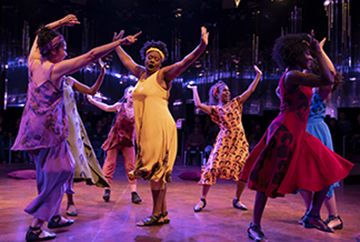
The scenes are of women in bright colored flowing garments stamped with photos of women in Afros. The sounds are African rhythms. Using narrative that is often poetry mixed with song and movement, they tell how they existed and survived in a world of sexism and racism. The sexism existed inside the racism, and it appears more insidious.
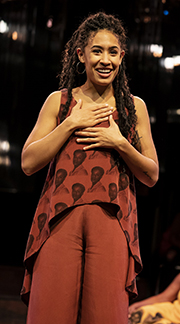
They have no names, are just identified by the colors of their garments. Under Leah C. Gardiner‘s smooth direction, they move in Camille A. Brown‘s Afro-inspired choreography to and around each other as they tell their narratives. Gardiner and Brown create the artistry that underpins Shange‘s feminist politics.
Lady in Brown (Celia Chevalier) was 8 years old in 1955 when in a St. Louis library she found the Haitian Toussaint l‘Ouverture, who refused to be a slave.
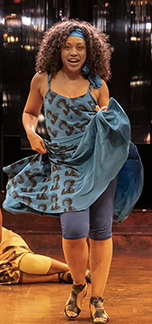
But most did not have that consciousness. They just want to be wanted. And they were na¯ve.
Lady in Yellow (Adrienne C. Moore) at graduation was “the only virgin in Mercer County.” She got drunk and lost it.
Lady in Blue (Sasha Allen) not Hispanic but from Spanish Harlem, would pretend to be Puerto Rican. She raised her powerful voice in soul singer anguish: “Eye crawling up on me, bones shattered, pregnant.”
But the nature of rape had changed. “We could have him over for dinner.”
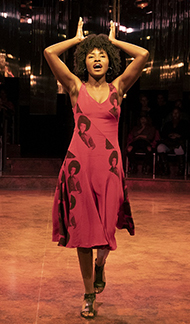
Lady in Red (Jayme Lawson) liked to dance with men. She was hot, a coquette. She wanted to be unforgettable. But to the guy who stands her up: “You call on weekdays. No, I can‘t drive 27 miles before going to work.” She begins to understand that women relinquish all personal rights in the presence of a man.
Lady in Green (Okwui Okpokwasili) is elegant, poetic, declaiming against “the man taking her stuff.” She means her identity.
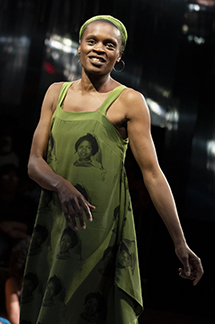
Harlem, they declare, is “six blocks of cruelty” where the men say, “I‘m sorry.”
The poetry, the dance and the music almost take the edge off the personal horrors they tell. Which includes a wrenching story of a man’s murder of his children.
Blue at the end declares, “I found god in myself, and I love her.” It is Shange’s declaration of her feminism.
For Colored Girls who have Considered Suicide/ when the Rainbow is Enuf. Written by Ntozake Shange; directed by Leah C. Gardiner; choreographed by Camille A. Brown. The Public Theater, 425 Lafayette Street (at Astor Place) New York City. 212.967.7555. Opened Oct 22, 2019, closes Dec 1, 2019. 90 min. 10/27/19. Also on NY Theatre Wire.

